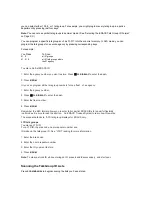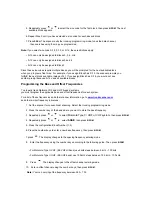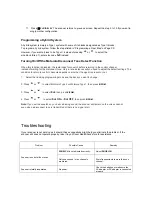
If the scanner is set to alert only the area you have
programmed,
F1
appears.
press
or
to change the displayed FIPS code from
F1
to
F15
.
If a FIPS code is not programmed, ------- appears.
Use the keypad to enter the FIPS code. Press
・
/CLR /DELAY
to cancel an inputted FIPS code.
Press
E/PGM
to store the FIPS code. Press
0
then
E/PGM
to clear a FIPS code. ------ appears.
If an invalid value has been inputted, the FIPS code is cleared.
To set the scanner so it alerts you when you receive any FIPS code, press
or
to move
ALLFIPS
. Then press
E/PGM
. Then go to WX hold mode.
To set to alert only the area you have programmed, press
or
to move
F1
to
F15
.
Then press
E/PGM
. Then go to WX hold.
Skywarn
The Skywarn function lets you jump directly to the last channel in memory (Channel 1000)
from any mode by press and holding
. The scanner goes into scan hold mode
and starts receiving transmissions in the last channel. If no frequency is programmed in the last channel,
No Prog
appears and the scanner sounds an error tone.
About Skywarn
Skywarn is an organized group of trained weather observers. A Skywarn group exists in virtually every US
county with a signifi cant population. During inclement weather, reports made by Skywarn observers include
information about:
•
pea-sized and larger hail
•
wind and wind gusts 40 MPH and greater
•
heavy rainfall
•
lightning (cloud-to-cloud and especially cloud-toground)
•
wall clouds seen in severe thunderstorms (which spawn tornadoes)
•
severe lowering of a wall cloud
•
turbulence in a wall cloud
•
funnel clouds
•
tornadoes
•
high water areas
•
downed power lines
•
other emergency conditions that affect life or property Listening to Skywarn broadcasts makes it easy to
quickly find out about and prepare for inclement weather conditions in your immediate area, even before your
local NOAA weather broadcast and local TV or radio station can announce them. Enter the local Skywarn
frequency for your area into Channel 1000 on your scanner. Then, listen to Skywarn fi rst when severe weather
threatens. Listen to NOAA: for weather alerts
Listen to Skywarn to hear trained observers in your vicinity call in
offi cial reports to a net control station which relays those reports to NOAA and other emergency agencies.
Most importantly, you get Skywarn reports directly from trained observers - that means you get them several
















































